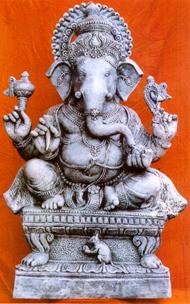GANESHA
AND HIS FESTIVAL |
|
The Amavasi preceding Vinayaka chathurthi and the Mahalaya amavasi, together form a base for a higher spiritual point synchronisig with the next Amavasi day. This is the Deepavali amavasi a symbol day of luminous wisdom which is celebrated as festival of lights. The dark forces of hell symbolised as Narakasura (Demon of the hell) are dispelled and the mind becomes happy in its own illumination. These three amavasi days constitute a triangle, the base laying between the amavasi preceding Vinayaka chathurthi and Mahalaya amavasi and the apex lying at the Deepavali amavasi. This imaginary triangle is the symbol of shaktipitam (seat of divine energy) and that is the reason why Sakthi the great mother of the universe is called Thrikonika. Her another name is Ganamba, the mother of Ganesha. We have seen that Vinayaka chathurthi a festival connected with Ganesha is followed by a number of other festivals. Ganesha being the inaugurating Deity, his part cannot be underestimated. During this festival of Vinayaka chathurthi people make his images in clay and after all the ritualistic worship and other religious formalities are over, they are thrown in water. This destruction has an esoteric significance. |
 From
this culmination point of pournami where the ego is at the height of its
conceit, there begins another waning cycle. In this waning phase the orbe
of the moon gets diminished every day and finally disappears in the darkness
of amavasi. This amavasi (new moon) coming after Vinayaka chathurthi is
a more meaningful festival called Mahalaya amavasi which means the great
merger of the mind with soul, bereft of all desires. Maha means the great
and laya means the spiritual merger of the mind with the soul. Mahalya
amavasi should be considered as a symbol of spiritual progress of the
devotee or sadhaka. The next nine days are observed by Hindus as holy
days. They go by the name of Navaratri during which people are expected
to worship Saraswathi Goddess of wisdom either by contemplative practices
or by ritualism. The tenth day is the symbol day of victory of wisdom
over ignorance and celebrated with great joy and enthusiasm. This tenth
day is called 'Vijaya dasami' (The victorious tenth day).
From
this culmination point of pournami where the ego is at the height of its
conceit, there begins another waning cycle. In this waning phase the orbe
of the moon gets diminished every day and finally disappears in the darkness
of amavasi. This amavasi (new moon) coming after Vinayaka chathurthi is
a more meaningful festival called Mahalaya amavasi which means the great
merger of the mind with soul, bereft of all desires. Maha means the great
and laya means the spiritual merger of the mind with the soul. Mahalya
amavasi should be considered as a symbol of spiritual progress of the
devotee or sadhaka. The next nine days are observed by Hindus as holy
days. They go by the name of Navaratri during which people are expected
to worship Saraswathi Goddess of wisdom either by contemplative practices
or by ritualism. The tenth day is the symbol day of victory of wisdom
over ignorance and celebrated with great joy and enthusiasm. This tenth
day is called 'Vijaya dasami' (The victorious tenth day).